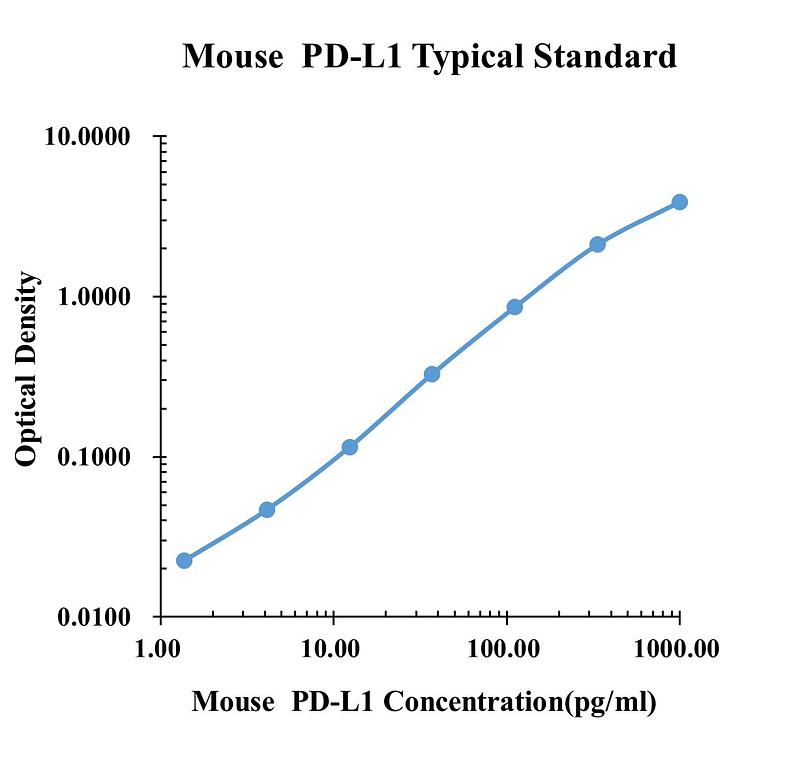Mouse PD-L1 enzyme-linked immunoassay kit
| Specification | 96 Test |
|---|---|
| Sensitivity | 0.16 pg/ml (10 μl) |
| Standard Curve Range | 1.37~1000 pg/ml |
| Standard Curve Gradient | 7 Points/3 Folds |
| Number of Incubations | 2 |
| Detectable sample | Liquid phase sample of soluble substances. For example: serum, plasma, cell culture supernatant, tissue grinding liquid, etc. |
| Sample Volume | 10 μl |
| Type | Fully Ready-to-Use |
| Operation Duration | 120min |

| pg/ml | O.D. | Average | Corrected | |
|---|---|---|---|---|
| 0.00 | 0.0578 | 0.0568 | 0.0573 | |
| 1.37 | 0.0794 | 0.0801 | 0.0798 | 0.0225 |
| 4.12 | 0.1089 | 0.0990 | 0.1040 | 0.0467 |
| 12.35 | 0.1731 | 0.1708 | 0.1720 | 0.1147 |
| 37.04 | 0.3835 | 0.3865 | 0.3850 | 0.3277 |
| 111.11 | 0.9157 | 0.9152 | 0.9155 | 0.8582 |
| 333.33 | 2.1664 | 2.1622 | 2.1643 | 2.1070 |
| 1000.00 | 3.9609 | 3.9586 | 3.9598 | 3.9025 |
Precision
| Intra-assay Precision | Inter-assay Precision | |||||
| Sample Number | S1 | S2 | S3 | S1 | S2 | S3 |
| 22 | 22 | 22 | 6 | 6 | 6 | |
| Average(pg/ml) | 24.1 | 109.5 | 371.6 | 24.4 | 127.7 | 359.1 |
| Standard Deviation | 0.8 | 6.8 | 8.5 | 1.0 | 3.9 | 6.9 |
| Coefficient of Variation(%) | 3.3 | 6.2 | 2.3 | 4.0 | 3.1 | 1.9 |
Intra-assay Precision (Precision within an assay) Three samples of known concentration were tested twenty times on one plate to assess intra-assay precision.
Inter-assay Precision (Precision between assays) Three samples of known concentration were tested six times on one plate to assess intra-assay precision.
Spike Recovery
The spike recovery was evaluated by spiking 3 levels of mouse PD-L1 into health mouse serum sample. The un-spiked serum was used as blank in this experiment.
The recovery ranged from 86% to 116% with an overall mean recovery of 107%.
Sample Values
| Sample Matrix | Sample Evaluated | Range (pg/ml) | Detectable (%) | Mean of Detectable (pg/ml) |
|---|---|---|---|---|
| Serum | 30 | 122.17-529.36 | 100 | 341.58 |
Serum/Plasma – Thirty samples from apparently healthy mice were evaluated for the presence of CRP in this assay. No medical histories were available for the donors. n.d. = non-detectable. Samples measured below the sensitivity are considered to be non-detectable.
Product Data Sheet
Background: PD-L1
PD-L1, also known as B7-H1 and CD274, is an approximately 65 kDa transmembrane glycoprotein in the B7 family of immune regulatory molecules. PD-L1 is expressed on inflammatory-activated immune cells including macrophages, T cells, and B cells, keratinocytes, enothelial and intestinal epithelial cells, as well as a variety of carcinomas and melanoma. PD-L1 binds to T cell B7-1/CD80 and PD-1. It suppresses T cell activation and proliferation and induces the apoptosis of activated T cells. It plays a role in the development of immune tolerance by promoting T cell anergy and enhancing regulatory T cell development. PD-L1 favors the development of anti-inflammatory IL-10 and IL-22 producing dendritic cells and inhibits the development of Th17 cells. In cancer, PD-L1 provides resistance to T cell mediated lysis, enhances EMT, and enhances the tumorigenic function of Th22 cells.

